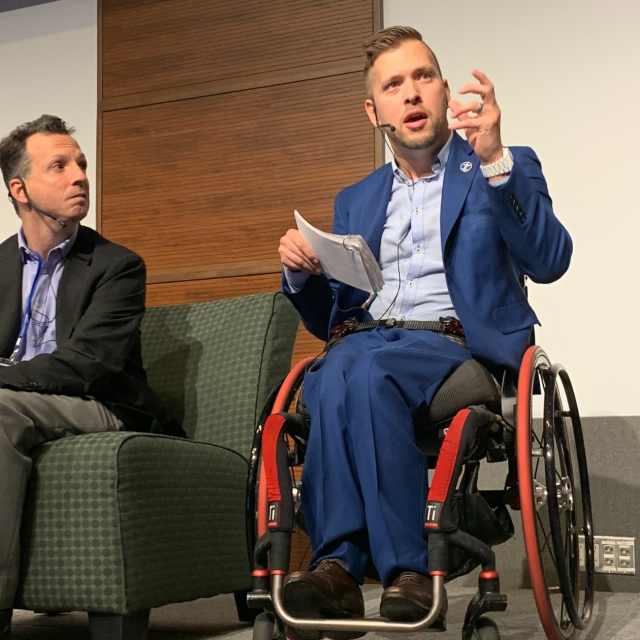Expert insights and innovative ways Toronto venues are providing barrier-free and inclusive spaces.
Creating an inclusive environment to ensure that all your attendees can actively participate is the best way to guarantee successful meetings. Venues with ramps, elevators and accessible washrooms are a good start, but planning for a truly accessible meeting takes a bit more work. We asked the pros for their advice on creating accommodating environments.

Choose venues that are accessible and easy to navigate.
Venue accessibility should be a top priority when choosing where to host your event, according to the CNIB Foundation, suggesting that planners conduct site visits to ensure all accessibility features are functional. Venues should also be easy to find and get to on public transit, with a clear and direct path from one venue to another, and simple, concise signage should be used that is always placed at the same height; having greeters on hand to assist is a great option, too.
Planners should conduct site visits to ensure all accessibility features are functional.
– CNIB Foundation
Toronto Venue to Consider for Accessibility
All eight levels of the barrier-free Metro Toronto Convention Centre are in compliance with Accessibility for Ontarians with Disabilities Act (AODA), wheelchairs are available and service animals are welcomed. Street level access to the building is close to public transit, and for multi-day meetings, the MTCC has the added convenience of being directly connected to Delta Hotels Toronto and the InterContinental Toronto Centre.

Arrange seating to accommodate those with sight impairment or mobility devices.
Providing ample room for attendees that require mobility devices or guide dogs, and arranging seating areas and displays away from direct paths of travel is advised under the Accessibility for Ontarians with Disabilities Act (AODA) guidelines for planning accessible meetings. Seating should also be provided close to presenters where there is a clear sight line, the area should be well-lit with lighting that can be dimmed or brightened, and that natural lighting, which can create shadows and glare for people with low vision, can be filtered or blocked by window coverings.
Provide diverse seating options to audience members, so that wheelchair users are not forced to sit at the back of the room, and avoid podiums on stage as speakers in wheelchairs will not be able to use them.
– Accessibility for Ontarians with Disabilities Act
Accessible spaces for speakers should also be top of mind — the team at the Rick Hansen Foundation recommends avoiding podiums, as speakers in wheelchairs will not be able to use them, using lapel mics instead of handheld and revamping the traditional format so that all speakers are seated, not just those in wheelchairs. It’s also a good idea to provide diverse seating options to audience members, so that wheelchair users are not forced to sit at the back of the room.
Toronto Venue to Consider for Accessibility
Vantage Venues is AODA compliant, has barrier-free entrances, an elevator system providing visual and audible cues, accessible washrooms and a welcoming approach to service animals. In the meeting rooms, window coverings are fully adjustable, and on-site staff can provide any specialized furniture or visual and audio aides that may be required.

Use assistive devices, technologies and services to assist attendees who are hard of hearing
Seating and lighting are also a factor for optimizing communication for hard of hearing guests, as are background noise and room acoustics, according to Canadian Hearing Services (CHS). Planners should consider having American Sign Language (ASL) interpreters for Deaf participants, Communication Access Real-time Translation (CART) and assistive devices such as FM systems to ensure an inclusive environment. Local organizations, such as CHS, can provide a pre-event consultation and help coordinate the services and devices required.
Toronto Venue to Consider for Accessibility
The Art Gallery of Ontario (AGO) is barrier-free and BlindSquare enabled — the GPS-app, developed for the blind, Deafblind and partially sighted, alerts devices to each described audio stop in the gallery, provides text-to-speech for in-gallery room panels and wayfinding directives. For neurodiverse visitors, the gallery offers relaxed visit times, access to sensory kits and a sensory map that highlights quiet zones.
Create an inclusive space for neurodivergent attendees
Planning for inclusive events often overlooks invisible impairments in the form of neurodiversity and other sensory-related issues. The Neu Project’s An Event Professional’s Guide to NeuroInclusion lists direct communication, such as simple venue signage and wayfinding, speech-to-text communications and closed captioning, a hybrid event format and quiet lounge spaces as best practices. The guide also suggests having sensory tools available, including fidget toys, weighted blankets and noise filtering headphones.
Provide direct communication, such as simple venue signage and wayfinding, speech-to-text communications and closed captioning, along with a hybrid event format and quiet lounge spaces.
— The Neu Project’s An Event Professional’s Guide to NeuroInclusion
Toronto Venue to Consider for Accessibility
While their specialty is Korean fried chicken, Sarang Kitchen is also known for their welcoming and inclusive environment for neurodivergent staff and guests. Co-founder Jennifer Low says that the restaurant has sensory-friendly hours before 9 p.m., when the music is calm, and offers sensory boxes that include noise-cancelling headphones, fidget toys and AAC boards that assist non-verbal individuals to communicate with others. Calming weighted blankets and bean bag seats are also available, and guests can use the multi-sensory room, with dimmed fibre-optic lighting, serene music and a fish tank, as needed.
